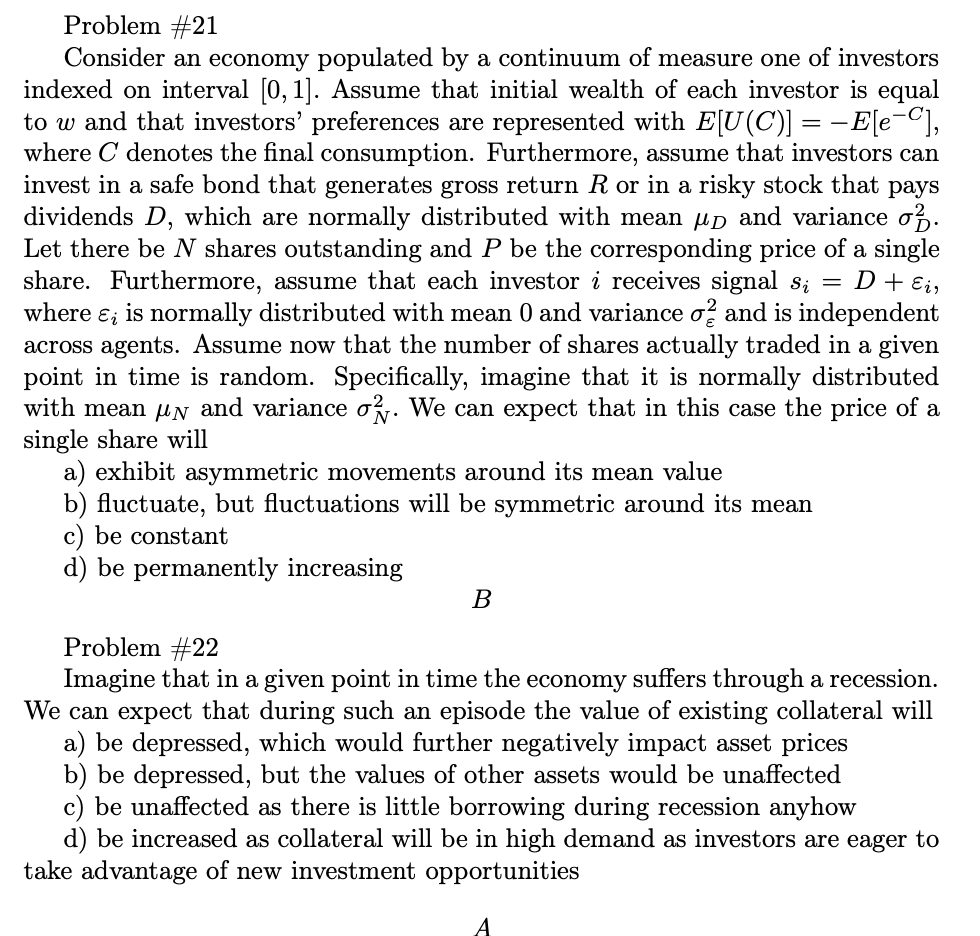
Problem \#21 Consider an economy populated by a continuum of measure one of investors indexed on interval [0,1]. Assume that initial wealth of each investor is equal to w and that investors' preferences are represented with E[U(C)]=E[eC], where C denotes the final consumption. Furthermore, assume that investors can invest in a safe bond that generates gross return R or in a risky stock that pays dividends D, which are normally distributed with mean D and variance D2. Let there be N shares outstanding and P be the corresponding price of a single share. Furthermore, assume that each investor i receives signal si=D+i, where i is normally distributed with mean 0 and variance 2 and is independent across agents. Assume now that the number of shares actually traded in a given point in time is random. Specifically, imagine that it is normally distributed with mean N and variance N2. We can expect that in this case the price of a single share will a) exhibit asymmetric movements around its mean value b) fluctuate, but fluctuations will be symmetric around its mean c) be constant d) be permanently increasing Problem \#22 Imagine that in a given point in time the economy suffers through a recession. We can expect that during such an episode the value of existing collateral will a) be depressed, which would further negatively impact asset prices b) be depressed, but the values of other assets would be unaffected c) be unaffected as there is little borrowing during recession anyhow d) be increased as collateral will be in high demand as investors are eager to take advantage of new investment opportunities Problem \#21 Consider an economy populated by a continuum of measure one of investors indexed on interval [0,1]. Assume that initial wealth of each investor is equal to w and that investors' preferences are represented with E[U(C)]=E[eC], where C denotes the final consumption. Furthermore, assume that investors can invest in a safe bond that generates gross return R or in a risky stock that pays dividends D, which are normally distributed with mean D and variance D2. Let there be N shares outstanding and P be the corresponding price of a single share. Furthermore, assume that each investor i receives signal si=D+i, where i is normally distributed with mean 0 and variance 2 and is independent across agents. Assume now that the number of shares actually traded in a given point in time is random. Specifically, imagine that it is normally distributed with mean N and variance N2. We can expect that in this case the price of a single share will a) exhibit asymmetric movements around its mean value b) fluctuate, but fluctuations will be symmetric around its mean c) be constant d) be permanently increasing Problem \#22 Imagine that in a given point in time the economy suffers through a recession. We can expect that during such an episode the value of existing collateral will a) be depressed, which would further negatively impact asset prices b) be depressed, but the values of other assets would be unaffected c) be unaffected as there is little borrowing during recession anyhow d) be increased as collateral will be in high demand as investors are eager to take advantage of new investment opportunities







